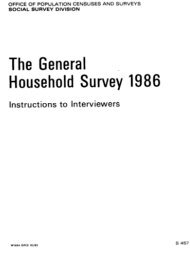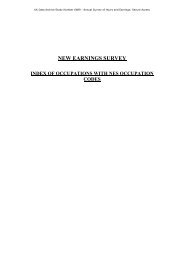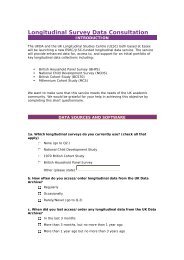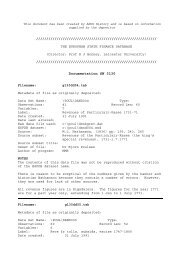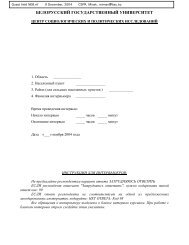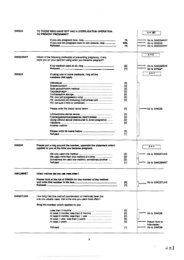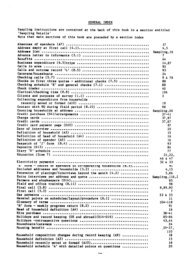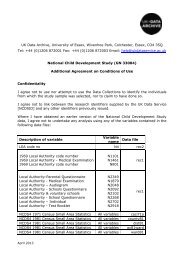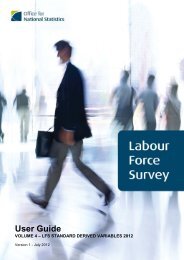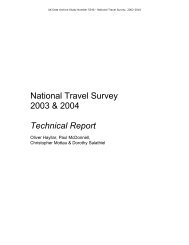- Page 1 and 2: Vol I INTERVIEWERS’ INSTRUCTIONS
- Page 3 and 4: ,, t< -1, 1 GHS Interviewer Instruc
- Page 5 and 6: NAIN SODY OF LIST The informatuan m
- Page 7 and 8: ,,, I 1’ 1. ! ~,’, 1- 1, . , L
- Page 9 and 10: # . . . . . . . . . . . . . . 7 , *
- Page 11 and 12: 34 Serial Number Labels 9 As well a
- Page 13 and 14: 5 NON-DIVIDEDANDDIVIDED ADDRSSS 11
- Page 15 and 16: Sur. e>. o . . . . . . lNumber. . .
- Page 17 and 18: 13 If you have any ,~erles c?ncernl
- Page 19 and 20: 5LlrVeV .............. Number. ....
- Page 21 and 22: 15 You WI1l generally be Instructed
- Page 23 and 24: I ~ Code 40 17 Households that are
- Page 25 and 26: ConventIons for Interview Schedules
- Page 27 and 28: The Residents Dear Resident(s) Offi
- Page 29 and 30: 11 USE OF INTERPRETERS 21 In some h
- Page 31 and 32: GENERAL HOUSEHOLD SURVEY s 511/1991
- Page 33 and 34: For all cases of non-response D COD
- Page 35 and 36: GENERAL HOUSEHOLD SURiE) 1991/’9?
- Page 37 and 38: 13.7 Admin time For 1991/92 a payme
- Page 39 and 40: GHS Intenlewer Instructions 1991/92
- Page 41 and 42: (lb) Date of Date of birth 1s place
- Page 43 and 44: IN CONFIDENCE GENERAL HOUSEHOLD SUR
- Page 45: PRESENT ACCOMMODATION ,. ,, Furpose
- Page 49 and 50: (3b) Q7 (contd) count as one room.
- Page 51 and 52: Q9 (contd) Q1O (5b) Exclude:- video
- Page 53 and 54: 11.In whose name is this (HOUSE/FLA
- Page 55 and 56: (6b) Q12 For tenure analyses, two t
- Page 57 and 58: 55 17. Who is it rented from? (Who
- Page 59 and 60: Housng Benefit (9a) From April 1990
- Page 61 and 62: 18. INTERVIEWER CODE r renting/shar
- Page 63 and 64: Fvrpose of section Q28 - Q33 Sale a
- Page 65 and 66: 34. To dl (including children) Ring
- Page 67 and 68: Q38 Q38(a) (12 & 13) (b) This IS an
- Page 69 and 70: 39. TO ALL - INTRODUCE CODE OR ASK
- Page 71 and 72: Q42 Q43(a) Q44 [ (1s) i ‘Forced e
- Page 73 and 74: FOR EACH OCCAS1ON AT Q40(a) ASK Qs
- Page 75 and 76: Sections added: Sections deleted: Q
- Page 77 and 78: 75 2 EMPLOYMENT 1. Did you do any p
- Page 79 and 80: Ql(a) Qla(i) (2b) Include any perso
- Page 81 and 82: Ql, 2 contd. Q2, 2a 79 (2d) People
- Page 83 and 84: (b) To those on YT or ET last week
- Page 85 and 86: 83 Q7(a) Q?(a)(i) Q7(b) Q7(c) (5b)
- Page 87 and 88: 7. (For those on ● govcrnmcot sch
- Page 89 and 90: Q8 A person should be coded as havi
- Page 91 and 92: 9. (Thnrkmg of your majn JOb) were
- Page 93 and 94: Qll F@ Qs12-14(a) Q12 Q12(b) (8) If
- Page 95 and 96: 13A. For employees (present main jo
- Page 97 and 98:
,, PENSIONS I , ~1 (lo) Q15-18 The
- Page 99 and 100:
. 17. Introduce if necessary (Now I
- Page 101 and 102:
Q19 Q20 Q21-25 Q21(a) (12) Here we
- Page 103 and 104:
13 22. Have you started any Jobs as
- Page 105 and 106:
(14a) Q24 Economically anactive .,
- Page 107 and 108:
26. Have you had a pa]d JOb or done
- Page 109 and 110:
QS 28-30 Q28 QS 29 6 30 Q29 Q30 . .
- Page 111 and 112:
31 To all aged 16-59 whose father i
- Page 113 and 114:
EDU~TION Purpose of section (18) Th
- Page 115 and 116:
Q4 113 (19b) An informant interview
- Page 117 and 118:
6, Hand informant card B Do you hav
- Page 119 and 120:
117 OTHER QUALIFICATIONS SCOTTISH E
- Page 121 and 122:
Code Code b not accept: (20) s (21)
- Page 123 and 124:
HEALTH Purpose of section (23) The
- Page 125 and 126:
Doctor consultations 4. During the
- Page 127 and 128:
Q5 Q6 Q6(a) Glasses and contact len
- Page 129 and 130:
Outpatient atteadmwca 5. During the
- Page 131 and 132:
I Q8 Q8(a) Q9 Q9(a) 1’ 1, ,, Q9(a
- Page 133 and 134:
10 Dental Health Can I just check h
- Page 135 and 136:
Q14 Q15 :20) The example given of a
- Page 137 and 138:
(a) Ask forcxch child whoconsul!ed
- Page 139 and 140:
Qs 18-20 Q18 Q20 (31) These are sum
- Page 141 and 142:
Dental Health 21. Enter person numb
- Page 143 and 144:
I I I 1 / I I \ I I I CHILD CARS (3
- Page 145 and 146:
7. To those coded 1 at Q3 (under 5s
- Page 147 and 148:
Q7(e) : Q7(i) ~ Q7(j) { {. (34) s (
- Page 149 and 150:
8. TO those coded 1 at Q6 (5 to 1IS
- Page 151 and 152:
Introduce 1. INTERVIEWER CODE 37 PE
- Page 153 and 154:
Q4 (38a) These guest~ons am to esta
- Page 155 and 156:
39 5. If any task coded 1 ‘Yes, n
- Page 157 and 158:
Q6 Q6(a) (40) This relatas to dcmas
- Page 159 and 160:
41 7 If any task coded 1 ‘Yes, ne
- Page 161 and 162:
;, Qs 9-10 Qs 9-10(a) (42) Q9 cover
- Page 163 and 164:
Show Card F 12 This M a hst of serv
- Page 165 and 166:
Q 13 ,. ., (44) Note that these ser
- Page 167 and 168:
Handling of guestlons (45b) There a
- Page 169 and 170:
1 TO all those aged 16-59 (a) Ask a
- Page 171 and 172:
SELF COMPLETION FORNS (46) Self com
- Page 173 and 174:
I 4A 4B (As you know some couples I
- Page 175 and 176:
Q1O QIOb, C QIOC QIO(g) t (48) The
- Page 177 and 178:
11 INTERVIEWER CODE (a) Is nrforman
- Page 179 and 180:
Qs16-20 DIVORCE (50) These quest~on
- Page 181 and 182:
21. INTERVIEWER CODE HOUSEHOLD BOX
- Page 183 and 184:
(52) Q24a Record detals for each ch
- Page 185 and 186:
28. INTERVIEWER CODE WOMAN ●ged 5
- Page 187 and 188:
Q31-47 Q31 Qs32-35 Q32AjQ32B Qs33-3
- Page 189 and 190:
36. INTERVIEWER CHECK Q35 37. INTER
- Page 191 and 192:
Q39A/Q39B Q39a Q39b ‘ Q40 Q43 (56
- Page 193 and 194:
41, To thoac with more than one usu
- Page 195 and 196:
Q46A Q46B A46C Q46B, Q46C Q46 (58)
- Page 197 and 198:
47 TO BE ANSWERED BY EVERYBODY ANSW
- Page 199 and 200:
INCOHE Purpese of Section - r,=7*:f
- Page 201 and 202:
(61a) Earnings as an employee (Qs 2
- Page 203 and 204:
., , 61 EARNINGS FROM WORK AS AN EM
- Page 205 and 206:
J QS 8-16 L7 QS 8, 16 & 20 QS 8 & 1
- Page 207 and 208:
15. What other deductions, If any,
- Page 209 and 210:
Q20 Q20(a) [. ,1 (64) In nmst cases
- Page 211 and 212:
21. Do You ever Ret ●n occuionaf
- Page 213 and 214:
(66) Earnmqs from self-employn!ant
- Page 215 and 216:
67 2S. DO YOU pay a National Insura
- Page 217 and 218:
Q30 6 30(a)-(c) Q30 Q30c ‘.? (68)
- Page 219 and 220:
69 31. To employees not workiog reg
- Page 221 and 222:
State benefIts (Q33) Qs 33 h 34 Gen
- Page 223 and 224:
(70 & 71) (C) Q34 For each bsinef~$
- Page 225 and 226:
(c) War disablement penwon (d) Inva
- Page 227 and 228:
Occupational mnslons (Qs 3S-42 ) (7
- Page 229 and 230:
74 42 (Apart from the pensions YOUh
- Page 231 and 232:
Q45 Q46 (75a) From April 1990 adult
- Page 233 and 234:
45. To those ●ged 18 and over 75
- Page 235 and 236:
233 (77b) Q49(a-c) should show the
- Page 237 and 238:
50. Show card O Do you have now, or
- Page 239 and 240:
(d) Post Office Savurg accounts (e)
- Page 241 and 242:
s51111PP1/92 GENERAL HOUSEHOLD SURV
- Page 243 and 244:
. GNS 1991/92 CODING @ EDITING NOTS
- Page 245 and 246:
GHS 1991/92 HOUSEHOLD SCHSDULE (la)
- Page 247 and 248:
Notes on Region Grouplnq (lC) RegIo
- Page 249 and 250:
(le) lil Relationship to HOH (Conti
- Page 251 and 252:
IN CONFIDENCE GENERAL HOUSEHOLD SUR
- Page 253 and 254:
GHS 1991/92 PRESENT ACCOMMODATION Q
- Page 255 and 256:
LXST OF ROOMS INCLUDED AT Q7 Backr~
- Page 257 and 258:
Question 7 (contnued) ... (3d) ROOM
- Page 259 and 260:
K Do you have any form of central h
- Page 261 and 262:
i. 259 Q9 Q1O CONSUMER DURABLES 1.
- Page 263 and 264:
6 TENURE 11. In whose name is this
- Page 265 and 266:
263 Q16 Code 1 includes, in additio
- Page 267 and 268:
265 17. \\’ho is it rented from?
- Page 269 and 270:
Q18 Q18 EC Q21 Q22 26-7, ....,.,:,,
- Page 271 and 272:
23. lNTERVIEWER CODE HHLDCHKC LA/Ne
- Page 273 and 274:
271 (11) Q28-29 ‘YOU’ means Hea
- Page 275 and 276:
34. To all (icrcIuding children) 12
- Page 277 and 278:
275 1. 2. 3. (12b) Answers are reco
- Page 279 and 280:
277 Notes on categories at Q38(a] B
- Page 281 and 282:
279 Other Asian (12f) Asian nationa
- Page 283 and 284:
Q38(a) Coding frame code 11 12 13 1
- Page 285 and 286:
283 .. Recoded from BLACK OTHER (co
- Page 287 and 288:
RECODED FROM MIXED ORIGIN (CODE 09~
- Page 289 and 290:
RECODED FROM NONE OF THESE (CODE 10
- Page 291 and 292:
. ~89, COUNTRIES: SUMMARY FRAME UNI
- Page 293 and 294:
291 14 15 16 Mediterranean Cormnonw
- Page 295 and 296:
7393 COUNTRY Afghanistan . . . . .
- Page 297 and 298:
COUNTRY Guinea (Republic) . . . . .
- Page 299 and 300:
. 297 COUNTRY Sabah (N Borneo) (Mal
- Page 301 and 302:
13 02 I 04 05 06 07 09 1 f O-4 year
- Page 303 and 304:
GHS 1991/92 HOUSEHOLD BURGLARY (14)
- Page 305 and 306:
FOR EACH OCCAS1ON AT Q40(a) ASK Qs
- Page 307 and 308:
EMPLOYMENT 1. Did you do any paid w
- Page 309 and 310:
3(I7 Q1 continued Looking for work
- Page 311 and 312:
Q2(b) Q4-5 Q4 Q6?+/B Q6C EC Q6C NOT
- Page 313 and 314:
.,. Q? OCCUPATION - VALID RANGE 100
- Page 316 and 317:
Q7 continued (5b) Ha]or Groups are
- Page 318 and 319:
Q7 1. 2. NB 3 4 (5d) Smplovee/self-
- Page 320 and 321:
5 7. (For those 00 a gowomcnl schem
- Page 322 and 323:
(6) Q8 If the Informant has more th
- Page 324 and 325:
9 (Th!nklng of your main lob) were
- Page 326 and 327:
Qlla/b Q12 Q12(a) Q12(b) (8) If the
- Page 328 and 329:
13A 13B . For cmployccs (present ma
- Page 330 and 331:
(lo) Q16 Smployers’ pensions Incl
- Page 332 and 333:
17 Introduce ~f necessary (NOU 1 Mo
- Page 334 and 335:
. Q19 Q20-23 12/13 ‘Looking for
- Page 336 and 337:
14 24. To all economically inactive
- Page 338 and 339:
Q27 15 The same procedures are used
- Page 340 and 341:
28. To those WhO have worked in the
- Page 342 and 343:
339 (17) Q31 Priority is given to t
- Page 344 and 345:
::, ‘. ). To those aged 16-69 Hou
- Page 346 and 347:
343 Q3 EC Q3 (18b/19) 2. ‘Further
- Page 348 and 349:
3 Apart from leisure classes, and ]
- Page 350 and 351:
(20/21a) The information given In t
- Page 352 and 353:
(20/21c) 1 +,1’J Q6 continued V1l
- Page 354 and 355:
Q6 continued EC Q6 (20/21e) Sub7ect
- Page 356 and 357:
Recognised trade apprentjccshlp COI
- Page 358 and 359:
23 HEALTH ] Over the Iasl 12 months
- Page 360 and 361:
Q4 (24a) ‘Talk to a doctor’ inc
- Page 362 and 363:
Q5 Q6 Q6(a) Q7 Q7(a) Q7(b),Q8 (25)
- Page 364 and 365:
8. In Ihc last year, that is since
- Page 366 and 367:
364 CHILD HEALTH SHEET (27) Qll Thi
- Page 368 and 369:
14.Now I’d likeYou 10 think about
- Page 370 and 371:
(a) Ask for eachcblld who consulted
- Page 372 and 373:
Q18-20 See notes for Q7-9 (31) Q20
- Page 374 and 375:
Dcn!a I Health 21. Enter person num
- Page 376 and 377:
GHS 1991/92 CHILD CARE (33a) The Ch
- Page 378 and 379:
1 (a) (b) lNTERVIEWTR CODE 33 CHILD
- Page 380 and 381:
Q7(a) (34LS) Intervle~er notes are
- Page 382 and 383:
Q8(a) Q8(d) Q8(e) Q8(h)&(i) (35) An
- Page 384 and 385:
36 ‘blank page’
- Page 386 and 387:
37 PERSONS AGED 65 AND OVER (ELDERL
- Page 388 and 389:
(38a) Q4 These questions alm to est
- Page 390 and 391:
Q5 (39) Answers at code 09 are (re)
- Page 392 and 393:
6. 1 would like 10 ask you about a
- Page 394 and 395:
,. ,: ,,, 391 Q7 Q8(b) Answers at c
- Page 396 and 397:
, 9, Do you ever go !O see relative
- Page 398 and 399:
,:1” ;1 “ ‘ Q12. Q12(a) Q12(b
- Page 400 and 401:
Show Card G 13. NOW here is another
- Page 402 and 403:
399 GHS 1991/92 FAMILY INFORMATION
- Page 404 and 405:
3. INTERVIEWER CODE Offer self-comp
- Page 406 and 407:
WHERE MARRIED (47) Q4 Included in p
- Page 408 and 409:
48 10. To all who are, or have been
- Page 410 and 411:
(49/50) DIVORCE/REMARRIAGEAND CHANG
- Page 412 and 413:
50 Applies if for last nmrriag? CL)
- Page 415 and 416:
21 INTERVIEWR CODE HoUSEHOLD BOX MA
- Page 417 and 418:
LIVE BIRTHS Q26 EC Q27 (52) Include
- Page 419 and 420:
28 INTERVIEWER CODE CHKFIC WOMAN a~
- Page 421 and 422:
CONTRACEPTION Q31 Q32 Q35 (54) Th~s
- Page 423 and 424:
36 INTERVIEWER CHECK Q35 S5 E]!hcr
- Page 425 and 426:
. Q39 Q39(a) EC Q39(a) Q39(b) Q4O (
- Page 427 and 428:
EC Q42 Q44 (57) A check IS made to
- Page 429 and 430:
46. A. from Q45 Show Card 1 \vhich
- Page 431 and 432:
427 (59) Q47(a) Answers coded 5 are
- Page 433 and 434:
1. INTERVIEWER CODE Code currentemp
- Page 435 and 436:
431 SPECIFIC POINTS ON QS 4-16 (61b
- Page 437 and 438:
& What was your wage or salary, inc
- Page 439 and 440:
,, . ,. 435 (62/63b) Qs 8-16 Codinq
- Page 441 and 442:
437 (62/63d) Time Period Frame: Tim
- Page 443 and 444:
1S. Uhat other dcduc!!ons. If any.
- Page 445 and 446:
Q19-20 EC Q19 EC Q20 Q20(b) (64a)
- Page 447 and 448:
Q21 EC Q21 (65) The information in
- Page 449 and 450:
22. EARNINGS FROM SELF-EMPLOVMENT (
- Page 451 and 452:
. .447 Q25 Q25(a) Q25(a)(i) Q27 ECQ
- Page 453 and 454:
28. (You ~old me you had a second j
- Page 455 and 456:
69 31 To employees not work]og resu
- Page 457 and 458:
Q33 & Q34 Q33(a) Q33(b) Q33(c) Q33(
- Page 459 and 460:
F5 Taxable benefits (70/71c) This b
- Page 461 and 462:
35 OCCUPATIONAL PENSIONS Are you al
- Page 463 and 464:
9 INTERVIEWER CODE h mformaast 81s0
- Page 465 and 466:
Q42 Q43/44 (74) Excluded from Q42 a
- Page 467 and 468:
$S TO those aged 18 and over 75 DNA
- Page 469 and 470:
Q49 Excludes (77b) Employment Rehab
- Page 471 and 472:
50. Show card O Mls (8) - (c) Do yo
- Page 473:
(d) Post Office Ssvins accounts (e)



